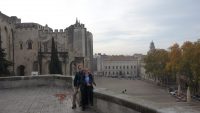 Breaking up is hard to do, unless you have a ton of resources at your back. From roughly 1300 to 1400, the Pope and his supporting bureaucracy moved the Papacy from Rome to Avignon. He moved because, according to the tablet-guides we used, “of political, religious, and economic reasons.” According to Dubbs, the Pope was kicked out. Either way, the Papacy was in Avignon, and the popes wanted to create a palace and supporting offices. In just twenty years, they built the old palace, and then subsequent popes kept adding on. But I get ahead of my touring self.
Breaking up is hard to do, unless you have a ton of resources at your back. From roughly 1300 to 1400, the Pope and his supporting bureaucracy moved the Papacy from Rome to Avignon. He moved because, according to the tablet-guides we used, “of political, religious, and economic reasons.” According to Dubbs, the Pope was kicked out. Either way, the Papacy was in Avignon, and the popes wanted to create a palace and supporting offices. In just twenty years, they built the old palace, and then subsequent popes kept adding on. But I get ahead of my touring self.
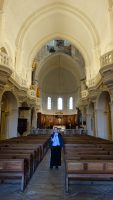 First, we started in the grand church next to the Popes’ Palace, Avignon’s Notre Dame. The church is very large, but not jaw-droppingly huge like St. Peter’s in Rome. It does have the advantage of being on a hill, so it has pretty views, and the golden statue of Mary on top of the church is huge, and very lovely. The interior of the church has many chapels off to each side, including one with a carved marble statue of Mary that is lit so subtly that we could not tell where the light was coming from. People were working in that chapel, setting up pews, so we could not get very close, but that was fine, since it left the lighting a mystery. One of the chapels also had a statue of Joseph holding Jesus, which is rare in my experience. There was a chapel with Mary holding the body of Jesus, and that chapel had the first black-and-white stained glass I can remember seeing, which was very appropriate for a chapel depicting the dead Jesus. Finally, there was renovation work going on near the entrance, and it made me smile that 80% of the multi-story scaffolding was hidden behind one single religious painting. That is one way to hide the work going on.
First, we started in the grand church next to the Popes’ Palace, Avignon’s Notre Dame. The church is very large, but not jaw-droppingly huge like St. Peter’s in Rome. It does have the advantage of being on a hill, so it has pretty views, and the golden statue of Mary on top of the church is huge, and very lovely. The interior of the church has many chapels off to each side, including one with a carved marble statue of Mary that is lit so subtly that we could not tell where the light was coming from. People were working in that chapel, setting up pews, so we could not get very close, but that was fine, since it left the lighting a mystery. One of the chapels also had a statue of Joseph holding Jesus, which is rare in my experience. There was a chapel with Mary holding the body of Jesus, and that chapel had the first black-and-white stained glass I can remember seeing, which was very appropriate for a chapel depicting the dead Jesus. Finally, there was renovation work going on near the entrance, and it made me smile that 80% of the multi-story scaffolding was hidden behind one single religious painting. That is one way to hide the work going on.
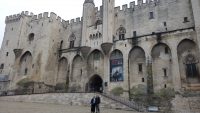 Back to the Popes’ Palace. It was home to nine popes, all of whom reigned for eight or more years; no “accidents” with this string of popes, and the election of the next popes went smoothly as well. It was not until there were competing Rome/Avignon popes elected that there were any issues, and I believe the Rome popes eventually won, ending the Avignon papacy, although the Pope did own the town itself until the French took it during the revolution in the late 1700s.
Back to the Popes’ Palace. It was home to nine popes, all of whom reigned for eight or more years; no “accidents” with this string of popes, and the election of the next popes went smoothly as well. It was not until there were competing Rome/Avignon popes elected that there were any issues, and I believe the Rome popes eventually won, ending the Avignon papacy, although the Pope did own the town itself until the French took it during the revolution in the late 1700s.
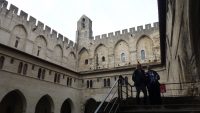 I had a first for me in touring – instead of an audio guide, we got iPad-like tablets which showed us a map of how to go through the rooms. This made my wife, who loves to see everything, very happy. Also, in each major room, there was a symbol that you could scan, and you would “time travel” back to the 1300s, and the tablet would show you what the room looked like at the time, virtually; wherever you held the tablet, it would show you that part of the room, with narration on the use of the room. It was really effective, but I had to keep reminding myself not to get so distracted with the virtual room that I forgot to look around the real room as it is now. Most rooms have lost their decorations over the last six hundred years, and most rooms had no furniture other than benches to rest on, so having the real and virtual rooms worked really well.
I had a first for me in touring – instead of an audio guide, we got iPad-like tablets which showed us a map of how to go through the rooms. This made my wife, who loves to see everything, very happy. Also, in each major room, there was a symbol that you could scan, and you would “time travel” back to the 1300s, and the tablet would show you what the room looked like at the time, virtually; wherever you held the tablet, it would show you that part of the room, with narration on the use of the room. It was really effective, but I had to keep reminding myself not to get so distracted with the virtual room that I forgot to look around the real room as it is now. Most rooms have lost their decorations over the last six hundred years, and most rooms had no furniture other than benches to rest on, so having the real and virtual rooms worked really well.
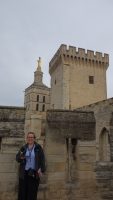 Some of the highlights? The treasury had hidden chambers under the flagstones for the most precious items and monies, and these floor panels were not discovered until the 1980s. It was an isolated room in the heart of the palace, and was protected by a wooden and iron door, which was still forced twice. The first time, the thieves were caught before they stole anything. The guide did not mention anything about the second time, so I assume they got away with some valuables.
Some of the highlights? The treasury had hidden chambers under the flagstones for the most precious items and monies, and these floor panels were not discovered until the 1980s. It was an isolated room in the heart of the palace, and was protected by a wooden and iron door, which was still forced twice. The first time, the thieves were caught before they stole anything. The guide did not mention anything about the second time, so I assume they got away with some valuables.
There was a huge hall that was used for banquets. The Pope and the cardinals sat up front on seats, and any lowly visitors, like ambassadors and nobility, had to share benches down the hall. No one was allowed to leave until an inventory of the goldware and silverware was completed.
There was a pretty little chapel off the dining hall that was lavishly decorated with the story of a local saint. Someone decided later it would be a perfect room for a lead-smelting furnace, with a chimney through the roof. Happily, somehow, much of the decoration survived.
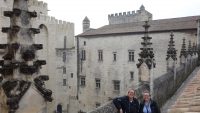 The large main chapel, used for important services during the church year, and for ceremonies like the election of a new pope, held an art exhibit of realistic drawings of (mostly) men, usually inspired by religious themes. They wore modern dress, and the artist hung the drawings on the sides of buildings all around the world and photographed the works and sometimes people viewing the work. It was very effective.
The large main chapel, used for important services during the church year, and for ceremonies like the election of a new pope, held an art exhibit of realistic drawings of (mostly) men, usually inspired by religious themes. They wore modern dress, and the artist hung the drawings on the sides of buildings all around the world and photographed the works and sometimes people viewing the work. It was very effective.
The tour ended on top of one of the towers of the palace, so we had grand views. Sadly, out of season in November, the rooftop cafe was closed, but we again enjoyed the entire palace with usually only two or four other people around. That was very useful in a few of the smaller rooms.
We were channeled though the gift shop, of course, and while Dubbs was picking out a few things for Christmas gifts, a tour group leader started asking Meredith some questions about where groups came out. Mer answered them as best she could, and only later did the woman come up and tell Mer that she’d thought that Mer worked there. Mer just has that kind of air of authority from years of teaching.
So, thumbs up to a great tour of the Popes’ Palace. Even after six hundred years and multiple uses by various groups, it is still very impressive (and huge – we saw relatively little of it, even though we took three hours).
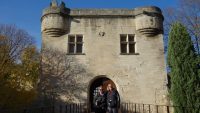 After a quick detour home to regroup, and a leisurely lunch, we headed over to the remains of the Avignon St. Benezet bridge. It was the first bridge built across the very large and very powerful Rhone river, built, according to legend, by the inspiration of the 12th century shepherd boy Benezet (Benedict), who claimed that God told him to get the people of Avignon to build a bridge. They laughed at him, and told him if God told him to build it, then he should pick up a huge bolder and carry it down the river to start the bridge, which he promptly did. Alternatively, historians think Benezet may have been a 12th century entrepreneur who started a bridge guild to make money. Either way, the bridge got started, and was worked on, on and off, for several hundred years, and sections were washed away on a regular basis. Many historians think the bridge was never fully completed in stone, and by the late 1600s, the bridge was not rebuilt. Four arches still remain, along with the gatehouse and drawbridge. The views from the end of the bridge are very pretty, both looking up the river, and looking back at the town. The views down river mostly are occupied by the much newer car bridge.
After a quick detour home to regroup, and a leisurely lunch, we headed over to the remains of the Avignon St. Benezet bridge. It was the first bridge built across the very large and very powerful Rhone river, built, according to legend, by the inspiration of the 12th century shepherd boy Benezet (Benedict), who claimed that God told him to get the people of Avignon to build a bridge. They laughed at him, and told him if God told him to build it, then he should pick up a huge bolder and carry it down the river to start the bridge, which he promptly did. Alternatively, historians think Benezet may have been a 12th century entrepreneur who started a bridge guild to make money. Either way, the bridge got started, and was worked on, on and off, for several hundred years, and sections were washed away on a regular basis. Many historians think the bridge was never fully completed in stone, and by the late 1600s, the bridge was not rebuilt. Four arches still remain, along with the gatehouse and drawbridge. The views from the end of the bridge are very pretty, both looking up the river, and looking back at the town. The views down river mostly are occupied by the much newer car bridge.
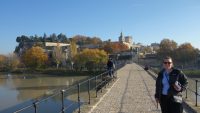 We got our art museum fix of the day by going to the very small Musee Angladon. It is a collection of art from the 1800s and 1900s, with a few big names like Degas and Van Gogh in the exhibit. The collection was donated from the estate of a wealthy fashion designer from the early 20th century. There were only about eight or ten rooms of a few paintings each, which made the museum easy to see, even at an easy pace. We were there for slightly less than an hour.
We got our art museum fix of the day by going to the very small Musee Angladon. It is a collection of art from the 1800s and 1900s, with a few big names like Degas and Van Gogh in the exhibit. The collection was donated from the estate of a wealthy fashion designer from the early 20th century. There were only about eight or ten rooms of a few paintings each, which made the museum easy to see, even at an easy pace. We were there for slightly less than an hour.
We finished the evening by doing a back-street walk though the twilight of Avignon. It started at a swanky hotel, where we got tea (and hot chocolate) and pastries, while getting to listen to a piano and violin duet. It was lovely and relaxing. The rest of the walk was through small lanes and back streets, past a pretty church and Avignon’s one synagogue, and ending near a water wheel in what used to be a cloth-makers’ street where there had once been 22 water wheels. On the way back to a restaurant to get supper, we stumbled across a cat cafe, so we all fawned over the kitties on the other side of the window for several minutes.
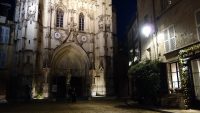
Supper was at a good crepe place, and we were the only customers until the last five minutes we were there. We enjoyed our food, but oddly, the staff had one song on repeat, so we heard a 40s-style French singer over and over and over and over. As background music went, it was fine, but hearing it about fifteen times or more was getting a little old by the end.
That ended a solid day of touring in Avignon. Mer has put me in charge of the next two days, so the pressure is on to find fun and interesting things to do, even without the resources of the papacy behind me. Here is to more touring!
Dubbs in not wrong, but the king of France, whose meddling was critical to get the (French) pope elected was also keen to have the Pope close by…the fact that French castles were right across the river probably didn’t influence Papal decisions at all…